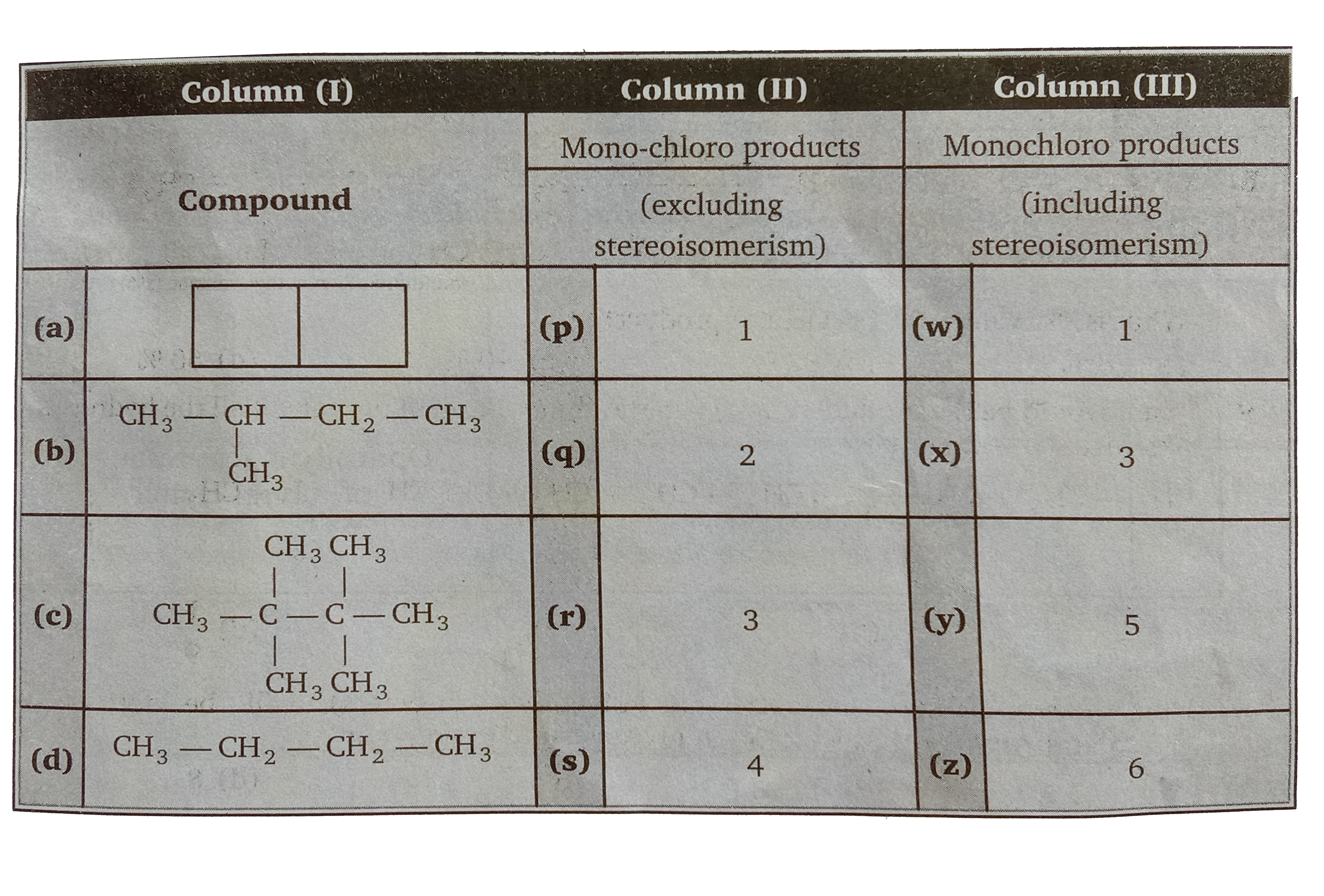Match the following columns
Column IColumn IIa. Cisacontic acidI. 2-carbonb. Fumaric acidII. 3-carbonc. 2-PGAIII. 4-carbond. Acetyl CoAIV. 6-carbon
a-I, b-II, c-III, d-IV
a-II, b-III, c-I, d-IV
a-IV, b-III, c-I, d-II
a-IV, b-III, c-II, d-I
The correct Answer is:D
To solve the matching question, we need to identify the number of carbon atoms in each compound listed in Column I and then match them with the corresponding number of carbon atoms in Column II.
1. Identify the number of carbons in Cisacontic acid:
- Cisacontic acid is a 6-carbon compound.
- Match: This corresponds to IV (6-carbon).
2. Identify the number of carbons in Fumaric acid:
- Fumaric acid is a 4-carbon compound.
- Match: This corresponds to III (4-carbon).
3. Identify the number of carbons in 2-PGA (2-phosphoglycerate):
- 2-PGA has 3 carbon atoms.
- Match: This corresponds to II (3-carbon).
4. Identify the number of carbons in Acetyl CoA:
- Acetyl CoA is a 2-carbon compound.
- Match: This corresponds to I (2-carbon).
Final Matches:
- a. Cisacontic acid → IV (6-carbon)
- b. Fumaric acid → III (4-carbon)
- c. 2-PGA → II (3-carbon)
- d. Acetyl CoA → I (2-carbon)
Answer:
- a → IV
- b → III
- c → II
- d → I
- Cisacontic acid is a 6-carbon compound.
- Match: This corresponds to IV (6-carbon).
- Fumaric acid is a 4-carbon compound.
- Match: This corresponds to III (4-carbon).
- 2-PGA has 3 carbon atoms.
- Match: This corresponds to II (3-carbon).
- Acetyl CoA is a 2-carbon compound.
- Match: This corresponds to I (2-carbon).
- a. Cisacontic acid → IV (6-carbon)
- b. Fumaric acid → III (4-carbon)
- c. 2-PGA → II (3-carbon)
- d. Acetyl CoA → I (2-carbon)
- a → IV
- b → III
- c → II
- d → I
Similar Questions
Knowledge Check
Match the following Columns.
Column IColumn IIA. DDT1. CO, CO2B. PAN2. smogC. Acid rain3. Biological magnificationD. Global warming4. SO2AABCD4321BABCD1234CABCD2341DABCD3241Match the column-
Column IColumn IIA Toxinsi. MorphineB Alkaloidsii. AbrinC Lectinsiii. VinblastinD. Drugsiv. Concanavalin A
ABCDiiiiiiiviiiiiiiviiiiviiiviiiiiiA1B2C3D4Match the following columns:
Column IColumn IIa.Oxylophytes(i)Calcium-rich soilsb.Eremophytes(ii)Waste landc.Chrysophytes(iii)Deserts, steppesd.Calciphytes(iv)Acidic soilsAa (i), b (ii), c (iii), d (iv)Ba (i), b (iii), c (iv), d (ii)Ca (iv), b (iii), c (ii), d (i)Da (iv), b (iii), c (i), d (ii)
Match the column I and II
Column IColumn II(a) Apocarpous(i) Papaver(b) Syncarpous(ii) Michellia(c) Epiphyllous(iii) Cashew(d) Cotyledon(iv) Aloe
View SolutionMatch the following Columns
Column IColumn IIA.Collateral and open(i)Cucubita stemB.Radial(ii)FernC.Bicollateral(iii)Maize rootD.Concentric(iv)Sunflower(v)Maize stem
View SolutionMatch the following columns:
Column IColumn IIAGolden riceiEli LilyBPCRiiHerbert boyerCInsuliniiiKary mullisDRecombinivPeter Bayer
View SolutionMatch the following columns
Column IColumn IIa.Lysozyme(i)HClb.Peptic cells(ii)Antibacterial enzymec.Saliva(iii)Sublingual glandd.Oxyntic cells(iv)Pepsinogen
View SolutionMatch theentries of Column 1 with those of Column 2.
Column 1Column 2A. Bulb(i) Sweet potatoB. Tuber(ii) BryophyllumC. Root(iii) OnionD. Leaf(iv) Potato
View Solution



